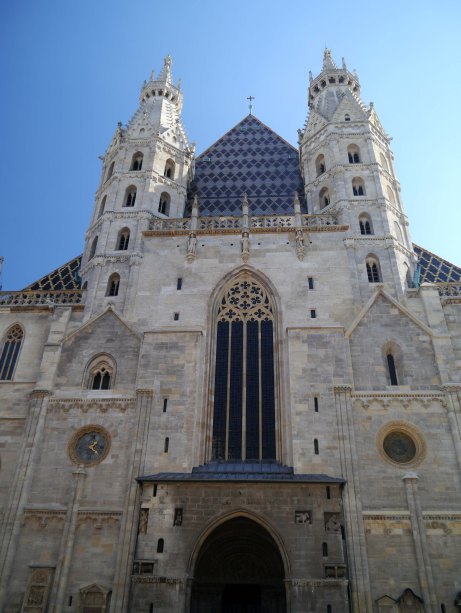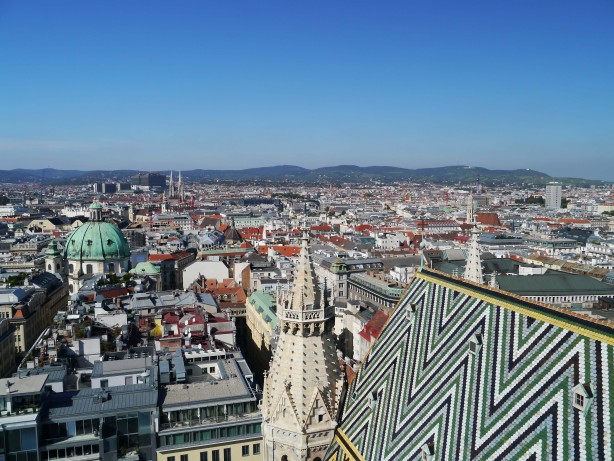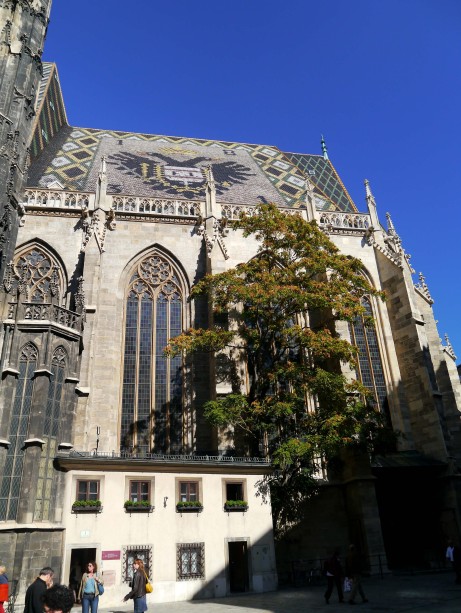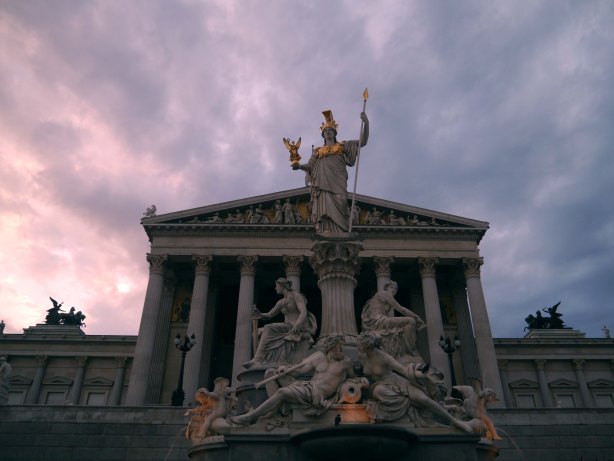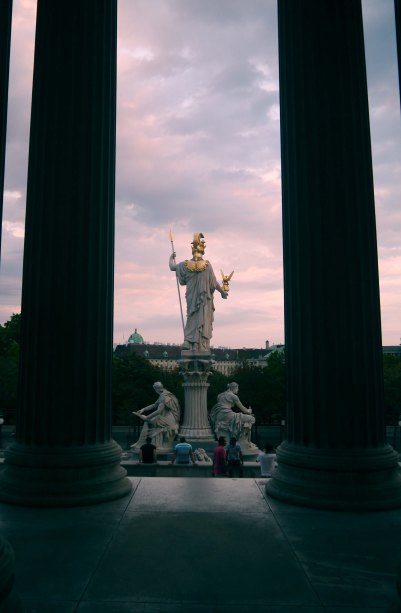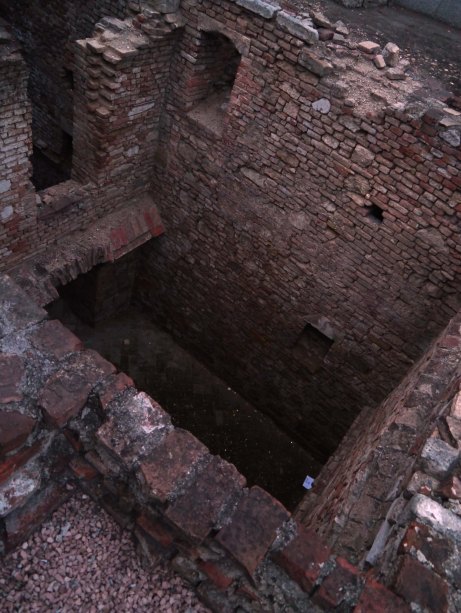On a nice friday we traveled outside of Vienna to Klosterneuburg and then to castle Kreuzenstein with our professor.
Klosterneuburg is both the site of a palace and a church. The church was built by St. Leopold III of the Babenburg dynasty. He married a woman named Agnes. There is a legend that says on their marriage day, Agnes’ veil was swept away and Leopold promised to build a church wherever it had landed. Eventually, he found the veil and built a church (with his wife’s money) and it became known as Klosterneuburg.
At the time it was built this church was the largest in the country. Klosterneuburg was also the capital of Austria until it was changed to Vienna by Henry II.
To the right of the church is the Baroque palace, which was the residence of Habsburg Charles VI, the last male Habsburg. Charles wanted to style his palace after one that he had seen in Spain and he had a plan to make it three times larger than it is now. Sadly, he died after only a third of it was finished and his daughter, Maria Theresa, wanted nothing to do with the palace, so construction stopped. Maria Theresa prefered Schönbrunn over Klosterneuburg.
The right tower was rebuilt in Gothic because it was damaged, while the left tower was rebuilt in Gothic, but during Baroque times. This is why the stones are different.
The inside of the church was redone in Baroque. Below is just an example of the glass windows lining the corridors outside the church. It is over 600 years old.
An organ made of pewter, which means it’s not used on a regular basis and there is another organ in the church used for everyday occasions.
Also in the church is the Verdun Altar, which was originally placed in front of the pulpit, but after a fire it was moved into the monastery. It now sits below St. Leopold III’s remains. His wife is also buried there with seven of their children, overall they had 17.
After our tour of the church, we made our way back into the Palace, which was quite impressive.
The dining room. The room is surrounded in 300 year old tapestries.
Each room had a giant stove or oven in the corner, which served as a heater and could keep a room warm for weeks with just one use.
One of the many sitting rooms.
The throne room.
Inside the palace is also the treasury. The most important treasure being the crown of Austria.
One of the more interesting treasures was a tusk, which had been carved into 170 figures.
After our tour of Klosterneuburg we traveled about an hour to Kreuzenstein, a medieval castle. It was probably one of the coolest castles I’ve seen and the kind of castle everyone pictures when they think of knights, the Middle Ages, and princesses.
This castle is owned by the Wilczak family. The original owner Count Johann Nepomuk Wilczek was a very rich man and decided that he wanted to rebuild the old medieval castle, which had been almost completely destroyed during the 30 Years War. Although the castle was originally medieval, Wilczek added some personal touches, which would not have originally been in the castle. He added in a library and also a small chapel.
We were lucky enough to get a tour inside the castle, but our professor says it’s become harder to do, because a book was stolen from the library. This also meant that we were not allowed to take photos inside the various rooms. Only the things outside were allowed to be photographed.
Because Wilczak was so rich, he funded his own expedition to the North Pole and has an island in the North Pole named after him. He didn’t hesitate in adding his own personal touches to the castle, by purchasing different things from all over the world that he found appealing.
Another fun fact about the castle is that part of the film The Three Musketeers (the 1993 version) was filmed here.
The outside of the castle was impressive, especially since it had a drawbridge and a moat. The moat was once filled with water, but now it’s been grown over.
A different view of the moat and drawbridge, which even had the metal gate with spikes. The smaller door to the right was used as an entrance after the larger bridge was drawn up. It also made it easier to dispatch anyone attacking the castle.
A catapult which was used to lay siege to the castle in Salzburg.
To the left is a replica of a torture device, luckily it has never been used.
Looking towards the entrance to the castle. This little corridor was my favorite and I could just imagine people walking up and down, going about their daily lives. I especially liked the little platform to the left and the creepy vines growing up the tower on the right.
Before entering the castle we visited the armory, which had a vast array of swords, armor, spears, lances, maces… anything you could possibly think of was there! The collection also included crossbows, which essentially brought an end to the time of the knights, because they could no longer fight their opponents with swords. There were also weapons of the farmers. Pitchforks, scythes, and our professor’s favorite weapon the Morningstar. Which was named as such, because it came from the east, where the sun rises. This weapon was essentially a metal ball, with four-inch long spikes protruding from all sides.
We were able to try on the chain mail that a knight would have worn. I only tried on the headpiece, but it was really heavy! Addison tried on both the head piece and the shirt. He looked quite official with the vast array of weapons behind him. Just the chain mail could way 50-60 kilograms or 110-130 pounds! Think about carrying around that weight all the time and then add on the weight of the rest of the armor. I don’t know how they moved!
Inside the castle we visited the chapel, which was very small, but with enough room for a crypt, where the family is buried. One of the reasons Wilczek built it was because he needed a place to bury his family.
We also got a tour of a bedroom, which had a chair-like bed in it. The mattress was sitting halfway up, because people believed that if you slept lying down you were dead and it was a sort of superstitious idea. They also had a board hanging on the side of the bed, so that they could write down any prophetic dreams they had during the night.
One of the rooms we saw was basically the hunting room. It had a giant stuffed boar, which I was not really a fan of, but it also had a fake horse head, with the horn of a narwhal attached. It was supposed to be a unicorn that Wilczek had hunted.
In the next room were a number of tables and one corner was called Wilhelm’s Corner, because it was where Emperor Wilhelm sat when he visited the castle for its grand opening.
Lastly, we were taken to the medieval kitchen, where many of the cookware is original. The table in the kitchen is so large that the entire room had to be built around it, rather than bringing it in after construction.
On our way out of the kitchen we ran across the owner of the castle, also a Wilczek. He was showing his family or friends around the place too.
One of the many cute doors leading into the castle. We only got to visit a few of them.
Like I said before, much of the castle was reconstructed, but it was also adjusted so that it fit Wilczek’s taste. He added in pieces of architecture he liked from all over the world. Windows from Hungary, wood from Germany, stone from Italy.
The section of the wall with the arches below comes from Italy.
Below is part of a church, taken from Slovakia. It is also one of the reasons the archway into the courtyard is so large. Normally, in a medieval castle, it would be much smaller so that it would not be easy for enemies to enter the courtyard and therefore take the castle.



















